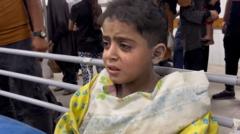Hatem Al-Atar, a 25-year-old civil defence worker in Gaza, is navigating the profound challenges of life amidst the wreckage left by ongoing conflicts. Since the war escalated on October 7, his duty has become a lifeline, drawing him close to the devastation surrounding him and to the memories of those he has lost. "All days of war since 7 October until now were difficult. Every second in this war was hard," he reflects, acknowledging the frailty of life in such a volatile environment.
Sitting with fellow comrades in the civil defence office in Deir al-Balah, Hatem is acutely aware that ninety-four of his colleagues have died, and over three hundred have been injured. His narrowly avoided demise, after an explosion rocked a house he was checking for survivors, underscores the perilous nature of his work. He recalls, “I remember when my father died. The violence feels endless,” while making a personal vow to continue rebuilding—for himself and for his deceased brother.
The ceasefire has sparked a slow return to normalcy for some, as many Palestinian families attempt to salvage what remains of their homes. Prof. Jumaa Abu Shiha reflects on the devastation as he surveys the remnants of what was once his family's sanctuary—a space built with love and care now reduced to rubble. “The feeling is indescribable,” he says, capturing the grief felt by many.
Local journalists are actively chronicling the reality of this ceasefire period, as departments like the UN work to address the immense needs created by the war. Despite accusations levelled against Israel regarding aid flow, trucks delivering essentials are arriving in Gaza, providing a lifeline to the nearly two million displaced residents.
However, the challenges extend beyond the physical. The war has left deep psychological scars, especially on children like ten-year-old Amr al Hindi, the lone survivor of his family after an Israeli strike. His story illustrates the tragedy that permeates this community; despite the sorrows, there is a flicker of resilience and hope that remains. He expresses a desire to fulfill his late brother’s dream of becoming a doctor, manifesting the drive for healing and recovery in every aspect of life.
The rebuilding process in Gaza reflects a complex tapestry of trauma, loss, and the aspiration for a future that transcends the horrors of past conflicts. Aid efforts continue alongside a growing realization that the true work lies in addressing the mental toll of war while providing essential material support. The narrative of survival is ongoing, as both the physical landscape and the human spirit strive to emerge from the ashes of devastation.



















